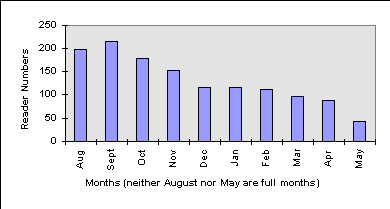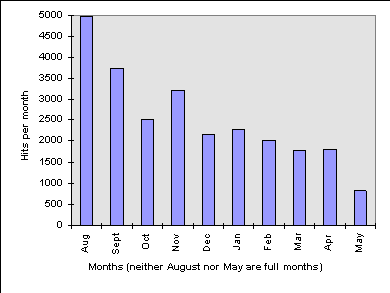
Figure 3: Monthly readership between late August 1998 and mid May 1999
The excavation report for Fife Ness was published in Internet Archaeology on 20th August 1998 and it rapidly ascended to the top six Internet Archaeology papers (a temporary position, but an interesting one nevertheless for a mesolithic site). Within a week of going live it had recorded over 3,000 hits (that is accessed pages) from around the world. I would guess that few of my previous publications have reached as wide an audience. Within six weeks well over a hundred registered readers had looked at the paper (Table 1), and the interest has continued so that over one thousand readers have now accessed the paper (Table 1 and Figure 3).
| Country of Origin | 30th September 1998 | 20th May 1999 |
| Africa | 2 | 4 |
| Asia | 5 | 14 |
| Australia | 12 | 35 |
| Europe | 46 | 175 |
| North America | 85 | 313 |
| South America | 3 | 9 |
| UK | 146 | 565 |
| Rest of the World | 2 | 9 |
| Blank | 124 | 37 |
| Total | 425 | 1161 |
Table 1 shows a pattern of interest around the world that would be hard to replicate with most conventional paper publications, certainly the journals that I have usually published in. While the reader figures show a steady decline (Figure 3), a general level of interest has been maintained. Figure 4 demonstrates that even after nearly a year, individual readers are making on average around 20 hits to the paper, suggesting that it is still being explored in some detail.

Figure 3: Monthly readership between late August
1998 and mid May 1999

Figure 4: Average hits per reader by month
between late August 1998 and mid May 1999
Readers of Internet Archaeology have to register, and this information helps to compile a user profile for the individual papers. The early profile for Fife Ness is recorded in Table 2, together with the profile at the time of writing. Future profiles may change dramatically as people have better equipment and easier (and cheaper) access to the Internet from their homes. The present profile reflects the current dominance of academic institutions as cheap providers of Internet services to the archaeological public.
| Type | Sept 30th 1998 | May 20th 1999 |
| Academic | 96 | 255 |
| Student | 65 | 301 |
| Public | 39 | 160 |
| Private | 76 | 273 |
| Other | 34 | 114 |
| Blank | 115 | 58 |
| Total | 425 | 1161 |
The Internet Archaeology records not only profile their readership in a detailed fashion, they also allow an exploration of how a paper is being used. In all, by the end of September 1998 there had been over 11,000 hits to the different parts of the paper, breaking down as follows ( Table 3).
| Part | Quantity of Hits |
| Open access areas, eg table of contents | 2,346 |
| main text and images | 4,664 |
| lithic catalogue | 433 |
| calmap | 3,711 |
| Canmore links | 110 |
| Grand Total | 11,264 |
By late November 1998, the initial surge of interest had settled down to some 2-5 readers a day, but there are still at the time of writing (May 1999) well over 500 hits a month (Figure 5). With time, no doubt, interest in the paper will fall off, though it will still be there for those who wish to refer to it. It will be interesting to see how the use of an excavation report pans out over the years. Personally, I would hope to see a general level of use by students, and sporadic continued interest from fellow professionals as well as, perhaps, a few hits from members of the 'public'.

Figure 5: Hits per month between late August 1998 and mid May 1999
© Internet Archaeology
URL: http://intarch.ac.uk/journal/issue7/wickham/readers.html
Last updated: Mon Sept 6 1999